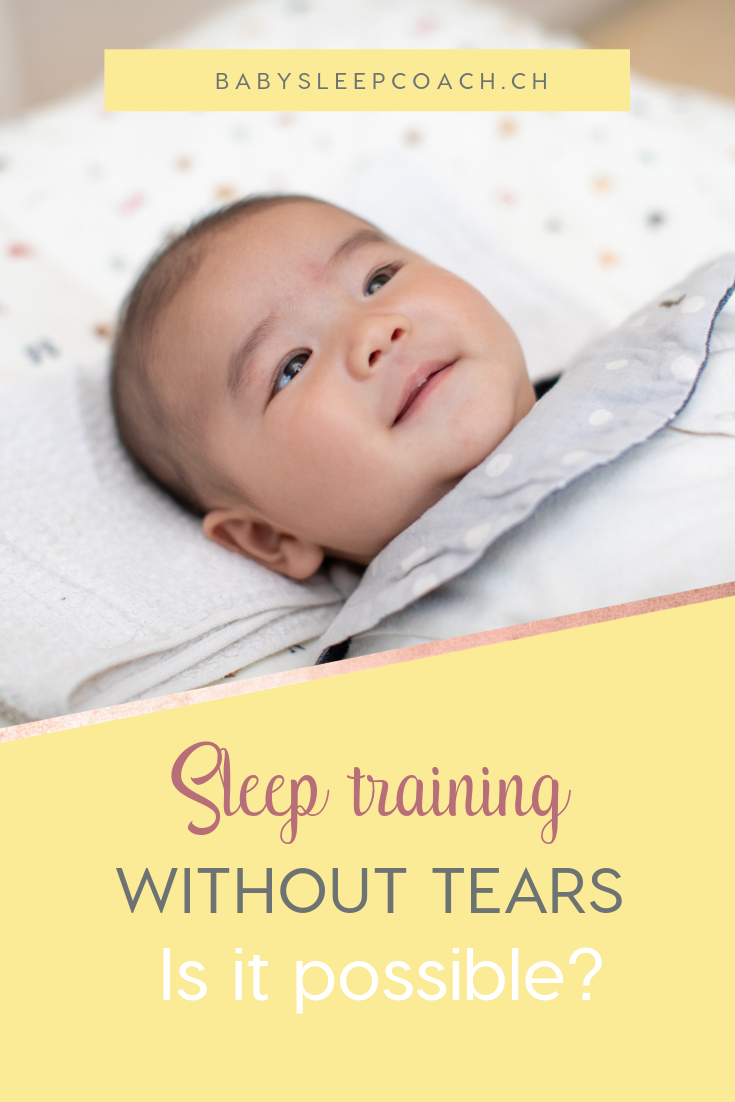“Do I have to let my baby cry in order for him/her to sleep better?!”
This is the most frequent question I get asked by families who are thinking about sleep training. Having 3 kids myself, I totally get it. Who likes hearing their baby cry, or feeling like they are causing their child to be upset?! I definitely don’t!!
This is why I help each family find a unique solution that works for them and their child. Just like each family is different, so is each child, and what works well for one baby may not be the best fit for another. The goal is to keep tears to a minimum, while helping baby learn healthy sleep habits that will improve not only their, but the entire family’s health and wellbeing.
But isn’t “sleep training” just forcing a child to do what the PARENT wants and letting them cry till they give up?!
NO!! At least not the sleep training I coach parents through!! (Read more about common sleep training myths here.)

“Sleep training” methods in general have gotten a bad rap, because they are largely viewed to be invasive techniques that simply “train” a child to behave in a certain way – the way the parents want.
But that’s not the case here at Sweet Babydreams!! (Which is why I prefer the term “sleep coaching”…)
During sleep coaching, we evaluate all aspects that are contributing to baby’s sleep, so that baby is encouraged to sleep the best he can for his age and biological ability.
5 aspects of sleep to optimise before sleep training
- Age-appropriate day routine – avoids overtiredness and helps achieve the best quality naps possible (start with the Dreamy Day Routines)
- Optimal sleep environment – provide a sleep-inducing atmosphere (read more here and here)
- Nutrition – ensure ideal nutrient intake
- Development – be aware of relevant milestones or sleep regressions
- Attachment – encourage secure, loving, responsive and consistent child-parent interactions
Fortunately, most of those factors are easily optimised with no crying at all!! And often enough, that’s all that’s needed to set sleep straight!
Let me give you an example.
From waking up every 1-2 hours to sleep through the night in just 2 days
I remember my very first client – a tired mama of a 16-month-old son, who’s waking up 6-10 times a night, screaming. At the time, he was doing 1 nap a day over lunchtime in a brightly lit room. The nap was too short for his age, so he was super overtired by bedtime. This led to him needing mom next to him while he fell asleep. Continuing on like this was unrealistic for mama, because she had 2 other kids to attend to (maybe you can relate?).
To help little guy sleep better, we re-introduced a short morning nap in addition to his lunch nap, and made his room dark for all naps to help lengthen his midday nap. Because he was less overtired, he learned to fall asleep independently after only 10 minutes of grumbling. (Those were the only tears shed through the whole process.)
This 16-month-old boy slept 12 hours through the night by night 2 of sleep training!
Sleep associations and sleep training
The one factor that I often takes a little longer to change is the sleep associations. Basically, the way a baby falls asleep for naps or at bedtime should be the way he falls back to sleep throughout the night or after one sleep cycle during a nap.
For example, if a child is 6 months or older, and is nursed to sleep at bedtime, then consistently wakes up every 2 hours in the night to feed, they are likely not hungry, but simply relying on mama’s magic milk to put them back to sleep. (Same thing applies to bottle feeding.) In order to change that association, the feeding needs to happen before the actual falling asleep part and the baby needs to learn how to fall asleep on his own.
This is where sleep training methods come in.
Before you begin sleep training, make sure you optimise ALL other factors! This naturally keeps tears to a minimum because you are setting the stage for good sleep!!
As with changing any habit (for us adults included!!!), frustration is a normal, even healthy part of the process. And the only way babies can express their frustration is through crying. So, there may be some tears in the first couple of days of sleep training.
If you feel uncomfortable with “letting your child cry”, by which parents often actually mean “leaving the room and ignoring your child and their emotions” my recommendation is that you:
1) stay in the room to settle your baby to sleep (there are gentle, in-room sleep training methods that work!)
2) acknowledge and support them as they express frustration
2) communicate empathy, calm and understanding
4) remain consistent in your approach (avoid these 10 mistakes and instead, follow these 7 secrets to successful sleep training)
So, is sleep training without tears possible?
While it’s normal for a baby to protest change and feel frustrated when learning to settle themselves to sleep, optimising all other aspects of sleep combined with a confident and consistent approach by the parent in weaning sleep associations keeps tears to a minimum.
Often, the child sheds fewer tears during sleep training than they did during so many fussy nights, overtired and upset.
If you’re frustrated with your baby’s sleep, but feeling guilty or torn about sleep training, I invite you to hop on a 15-minute sleep consult with me to discuss a gentle approach that would suit your family.
